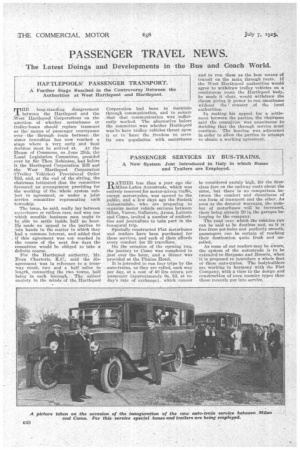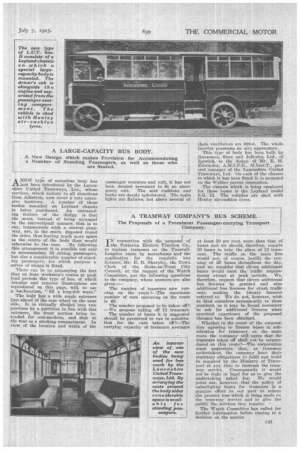PASSENGER TRAVEL NEWS.
Page 30

Page 31

If you've noticed an error in this article please click here to report it so we can fix it.
THE long-standing disagreement between the Hartlepool and the West Hartlepool Corporations on the question of whether motorbuses or trolley-buses should replace tramcars as the' means of passenger conveyance over • the through route between the sister townships has now reached a stage where a very, early and final decision must be arrived at. At the House of Commons, on June 25th, the Local Legislation Committee, presided over by Sir Thos. Robinson, had before it the Ffartlepool Corporation Bill and the West Hartlepool Corporation 1(Trolley Vehicles) Provisional Order Bill, and, at the end of the sitting, the chairman intimated that the committee favoured an arrangement providing for the working of the whole system subject to agreement, or under a joint service committee representing each township.
The issue, he said, really lay between motorbuses or railless cars, and was one which sensible business men ought to be able to settle inside half an hour. He made an appeal to the parties to join hands in the matter in which they had a common interest, and added that if this agreement was not reached in the course of the next few days the Committee would be obliged to take a definite course.
For the Hartlepool authority, Mr. Even Charteris, K.C., said the disagreement was in reference to a tramway ron0, two and a half miles in length, connecting the two towns, half being in each borough.. The salient anxiety in the minds of the Hartlepool
Corporation had been to maintain through communication, and to ensure that that communication was sufficiently worked. The alternative before the committee was whether Hartlepool was to have trolley vehicles thrust upon it or to ' have the freedom to serve its own population with motorbuses
RAT'HER less than a year ago the Milan-Lakes Autostrade, which was entirely reserved for motor-driven traffic, except motorcycles, was opened to the public, and a few days ago the Societa Autostradale, who are preparing to organize motor vehicle services between Milan, Varese, Gallarate, Arena, Lainate and Como, invited a number of authorities and journalists to take part in the inaugural trip.
Specially constructed Fiat motorbuses and trailers have been purchased for these services, and each of them affords every comfort for 20 travellers.
On the occasion of the opening run, the journey to Como was completed in just over the hour, and a dinner was provided at the Plinius Hotel.
It is intended to run four trips by the auto-trains, as they are called, each way per day, at a cost of 40 lire return per, passenger (approximately 6s. 2d. at today's rate of exchange), which cannot
and to run them as the best means of transit on the main through route. 11 the West Hartlepool authorities would agree to withdraw trolley vehicles on a continuous route the Hartlepool body, he made it clear, would -withdraw the clause giving it power to run omnibuses without the consent of the local authorities.
In making his appeal for a settlement between the parties, the chairman said the commiltee was unanimous in deciding that the through service must continue. The hearing was adjourned in order to allow the parties to attempt to obtain a working agreement. .
be considered unduly high, for the firstclass fare on the railway costs about the same, but there is no comparison between the comfort and cleanliness of oneform of transport and the other. As soon as the demand warrants, the number of motorbuses will be increased, there being already 20 in the garages belonging to the company.
The road over which the vehicles run can be said to he dustless and, as it is free from pot-holes and perfectly smooth, passengers can be certain of reaching their destination quite fresh and unsoiled.
As some of our readers may be aware, the system of the autostrade is to be extended to Bergamo and Brescia, when it is proposed to introduce a whole fleet of these auto-trains. The bodybuilders arc working in harmony with the Fiat Company, with a view to the design and construction of even roomier types than those recently put into serviCe. • ANEW type– of motorbus body has lijust been introduced by the Lancashire United •Tramways, Ltd., whose services, which radiate in all directions from Atherton, now cover a very extensive territory. A number of these bodies mounted on Leyland chassis is being purchased. An outstanding feature of the design is that the seats, instead of being arranged in the conventional manner, that is to say, transversely with a central gangway, are, in the main, disposed round the sides, thus leaving much more space in the centre of the body than would
otherwise be the ease, By following this arrangement it is possible not only to accommodate 38 sitting passengers, but also a considerable number of standing passengers, for which purpose a series of straps is fitted.
There can be no gainsaying the fact that on busy workmen's routes at peak Toad periods this type of bus, of which interior and exterior illustrations are reproduced on this page, will, to use a hackneyism, "fill a long-felt want."
The body has a wide single entrance just ahead of the rear wheel on the near side. It is virtually divided into two portions by a partition in line with this entrance, the front portion being intended for non-smokers, and that at the rear as a smoking compartment. In view of the location and width of the
passenger entrance and exit, it has not been deemed necessary to fit an emergency exit. The seat cushions and backs are deeply upholstered. The main lights are fixtures, but above several of IN connection with the proposal of the Potteries Electric Traction Co., to replace tramcars on the TunstallLangton route by motorbuses anct the application for the requisite bus limnces,-Mr. E. B. Sharpley. the Town Clerk of the Stoke-on-Trent City Council, at the request of the Watch Committee, put the following questions to the company, whose answers are also given:—
The number of tramcars now running on the route?—The maximum number of cars operating On the route is 48.
The number proposed to be taken off? —We propose taking off 13 tramcars.
The number of buses it is suggested should be permitted to run in substitution for the cars taken off?—The carrying capacity of tra.mears averages them ventilators are fitted. The whole interior possesses an airy appearance.
This type of body has been built by Bansomes, Sims and Jefferies, Ltd., of Ipswich, to the design of Mr. E. H. Edwardes, A.M.I.E.E., M.Inst.T., general manager of the Lancashire United Tramways, Ltd. On each of the chassis to which it has been fitted it is mounted on the Webber patent suspension.
The chassis which is being employed for these buses is the Leyland model S.G. 11. The vehicles are shod with Henley air-cushion tyres.
at least r,0 per cent, more than that of buses and we should, therefore, require 20 buses to. take the place of 13 tram cars. The traffic on the main line would not, of course, justify the running of 20 buses throughout the day, and we consider that eleven additional buses would meet the traffic requirements except at peak periods. We, therefore, request that eleven additional bus licences be granted and nine additional bus licences for crush traffic only, making the twenty licences referred to. We do not, however, wish to bind ourselves permanently to these .numbers, as it may be found necessary to ask for additional licences when practical experience of the proposed changes has been obtained.
Whether in the event of the corporation agreeing to licence bases in substitution for tramcars on the main route the company will agree that the tramcars taken off shall not be reintroduced on this raute?—The corporation must appreciate that, as tramway undertakers, the company have their statutory obligations td fulfil and could be required by the Ministry of Transport at any time to increase the tramway service. Consequently it would not be right or legal for us to give the undertaking asked for. We would point out, however, that the policy of substituting buses for tramcars is a genuine effort on our part to reduce the present loss which is being made on the tramway service and to give the public the services they .require.
The Watch Committee has called for further information before coming to a decision on the matter.














































